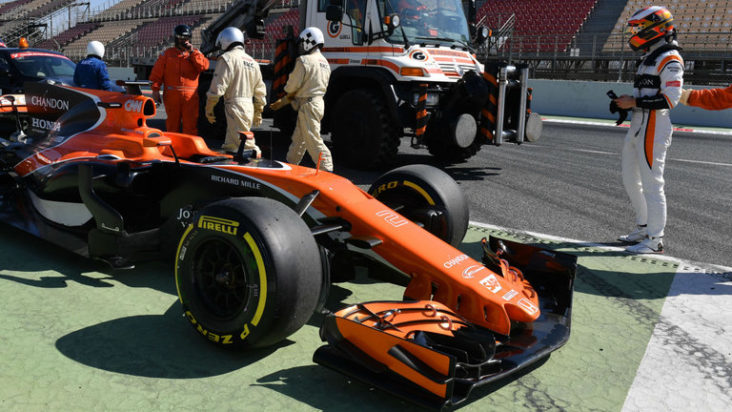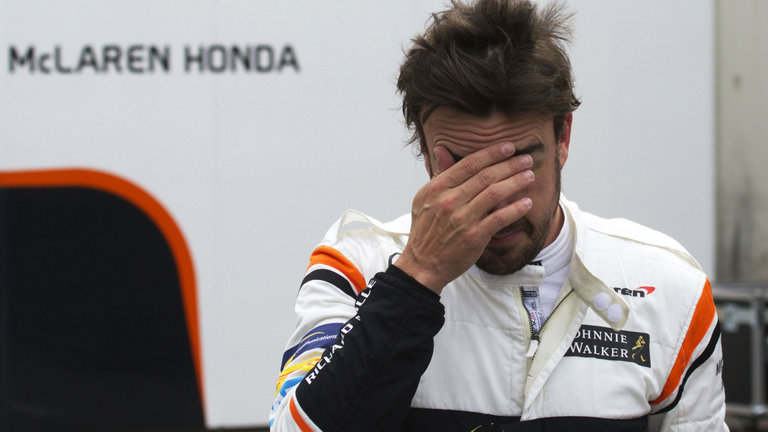F1’s sleeping giants – Where it all went wrong at McLaren

By Callum Springall
Since 2013, McLaren have been on what is euphemistically described as a slump – in the same way that Blackburn Rovers have experienced a ‘slump’ in recent football years.
It all started with some ill-advised design changes between 2012 and 2013, before a disastrous engine switch to Honda appeared to reunite the glorious partnership of the late eighties and early nineties – only for the Woking machines to be powered by nightmares, not dreams.
The second most successful team in Formula 1 began its decline in 2013, resulting from inherent design flaws in the MP4-28 that meant they couldn’t capitalise on their end of season surge in 2012 – that included wins in Texas and Sao Paulo for Lewis Hamilton and Jenson Button respectively.
McLaren have had no wins since, partly due to the misgivings of the 2013 car and their causes. Having overhauled parts of the car while the regulations were relatively stable, McLaren changed to a pull rod front suspension despite Ferrari’s lack of success with the design in preceding years. In turn they went from the team to beat in Brazil, to a rival of Force India in Melbourne the following March.
Paddy Lowe’s confirmed move to Mercedes later in the year compounded the problem for the rest of the season, as well as much of 2014, as the keys to the design office were handed over to Tim Goss – hardly a marquee name.
However, standout drives from Button in Malaysia, China and Brazil – and from Sergio Perez in India – suggested they would have been potentially race-winning performances with a better package that year.
The MP4-29 was hardly an improvement. It was billed as a race winner by Ron Dennis – one of the few times when ‘Ronspeak’ equated to ‘porkies’ – but the team only registered two podium finishes, both in the opening round in Melbourne, Australia.
In spite of having the best engine by some distance Ferrari still toppled their arch nemeses in the constructors’ table, while engine suppliers Mercedes often held a two-second advantage over their customers.
Peter Prodromrou’s recruitment spurred some late progress as Button registered strong performances on a consistent basis until season’s end – seemingly wasting his best years away in substandard machinery. Nonetheless they moved some way closer to the likes of Williams, Ferrari and Red Bull. That meant if the Honda engine was as much of a ‘gem’ as Dennis claimed it to be, McLaren stood on the edge of something resembling a revival.
Even the late winter addition of Fernando Alonso yielded hope for McLaren wins and potentially the Spaniard’s long-awaited third crown.
But the warning signs were there before the 2015 car even broke wraps. Stoffel Vandoorne tested a mule in the Abu Dhabi young driver test in late 2014, and barely completed a handful of laps over the course of two days. Oh, how ominous it all was. Only the most optimistic fan would look past such issues – fans such as yours truly.
In 2015 the team was finally reunited with Honda, which gave way to a season constantly hamstrung by persistent unreliability and a chronic impotence to match. Conversely, the design team at Woking seemed to improve matters, producing a car that two of the best drivers on the grid often complimented generously – or was it all a load of PR guff?
SUBSCRIBE: Listen to The NR F1 Podcast on your chosen podcast player
Even so, solid results on less power-dependent circuits seemed to hint at some improvement on the aerodynamic side. The first points of the season came for Button in Monaco, and the former champion – and apparently avid Queen fan – narrowly missed out on a Q3 appearance, as if the true pace of the car was in any doubt.
A double points finish in Hungary and what should have been another top 10 for Button in Singapore, notwithstanding some over-exuberance from Pastor Maldonado and a gearbox failure, suggested the team were on the up.
On this occasion, McLaren’s late season upturn actually spilled over into the following year, as the evolved MP4-31 was an immediate and consistent improvement over its predecessor in just about every way.

In spite of incremental improvements to both power and reliability, to the extent both could be regarded as respectable, Honda broke away from their size-zero philosophy and what seemed like a clear and consistent plan – and instead attempted to emulate the Mercedes engine architecture by splitting the turbo and the compressor.
That works in principle since the turbine isn’t heating the compressor, so incoming air is cooler and thus the engine is more efficient. Apparently.
However, the break from philosophy would on the face of it appear to have cost Honda in relative terms when compared to Mercedes. We can also look at it in such a way that Honda now has a solution that is proven to work, although I would argue – as I did in my Ferrari piece way back in February – that consistency and stability are what facilitate long-term, repeatable success.
The gist of the situation is that every team ought to develop their own strengths, born out of their own long-term planning and philosophies. If we look back through the ages, that statement tends to hold true.
Red Bull’s success was built largely on the blown exhaust and the engine mapping from Renault that forced more exhaust gases to the diffuser while off-throttle, which suited Sebastian Vettel to the ground.
At Ferrari, the Michael Schumacher era was about merging the engine and aero sides to allow the car to be designed as one, whereas before it was partly designed in Guildford by John Barnard and partly in Maranello, which hindered communications and transparency between the two departments.
The way in which the current champions have tasted such success is similar to Ferrari under Ross Brawn, although much of the success came about due to early and substantial investment, so it was three championships made in Stuttgart as it was made in Brackley and Brixworth. Merge that with the recruitment of Bob Bell, Aldo Costa and company, and success is practically a given.
So which of these has Honda done in the four years since the announcement of their return?
Well, they haven’t necessarily exploited the rules with the size-zero concept, but it certainly changed the tide in other manufacturers’ engine designs – so it must have been the right idea to a point.
In rudimentary terms it does lend itself to the car’s aerodynamic advantage, since more air was getting to the diffuser and creating more rear stability – although it didn’t help at all with the reliability of the engine components, which were likely too hot to cope and not engineered with the same know how as a Mercedes, Ferrari or Renault. Energy harvesting became a major headache throughout 2015 and crippled the speed at the end of a straight.
So while it was a nice idea, it doesn’t make any difference when you have no power or reliability, which can be pinned on the fact Honda did not have the same period of investment or prior research as Mercedes. Nor did they have the same expertise. In short, they were under-prepared and out of their depth.
That being said the important thing after 2015 was improvement, which they got throughout 2016 and therefore a switch to the Mercedes concept – from the outside – appeared a misguided split from tradition that jeopardises Honda’s whole latest F1 escapade and its partnership with McLaren. It looks a knee-jerk reaction when they could have built on the steps they had already taken, in turn screaming inexperienced technical leadership and leading me nicely on to my next point.
 Honda have always insisted on breeding their own engineering talent – as is their company policy in general – rather than bringing in someone who is proven to be among the best in the land.
Honda have always insisted on breeding their own engineering talent – as is their company policy in general – rather than bringing in someone who is proven to be among the best in the land.
They aren’t the type to go and poach Andy Cowell or enlist the services of Mario Ilien, which isn’t fundamentally an issue. It’s just they’ve been out of F1 for so long that not enough people at Honda have the applicable knowledge needed to succeed without the kind of latent progress they have experienced.
In summary, Honda – and McLaren – may well have got to the top before the next metamorphosis of the regulations, likely to come around 2020-21 I would hesitantly estimate.
If we use Ferrari as a case in point, they seemed to have designed a better, more driveable car out of the blocks compared to Mercedes, despite it looking significantly more understated than that of their rival. It says they have followed their own philosophy and avoided the costly headaches suffered by Mercedes – and more specifically, Lewis Hamilton – at Russia and Monaco, most notably.
So after all the grief and lack of applicable know how, Honda may have waded through all the lost time and money to claim the success that makes the pain worthwhile.
Suddenly, I feel slightly odd writing this while listening to Green Day’s Time of Your Life because before the philosophy shift this year, it could all have come good.
Even if they had lost Alonso, Vandoorne is a more than capable replacement once he gains more experience. But the point is McLaren and Honda had the chance to grow together – along with the Belgian – to achieve the ultimate.
Instead, Honda have moved closer to killing the McLaren reunion and pushed themselves into what could become a marriage of convenience with Sauber.
♦ Callum Springall is a blogger with the NRF1. You can follow Callum on Twitter @callumspring18


One thought on “F1’s sleeping giants – Where it all went wrong at McLaren”